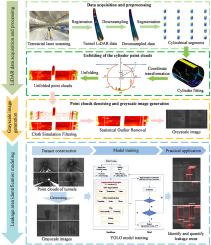基于激光扫描数据和深度学习网络的盾构隧道衬砌泄漏区域自动检测与量化
IF 8
2区 计算机科学
Q1 AUTOMATION & CONTROL SYSTEMS
Engineering Applications of Artificial Intelligence
Pub Date : 2025-08-05
DOI:10.1016/j.engappai.2025.111930
引用次数: 0
摘要
本研究提出了一种自动识别和量化盾构隧道漏水的方法,该方法将激光扫描获得的光探测和测距(LiDAR)数据与You Only Look Once (YOLO)深度学习网络相结合。该方法通过光栅化处理将激光雷达数据转换为灰度图像,然后对图像进行标记,训练YOLO模型,该模型可以检测和分割隧道衬砌上的泄漏区域。该方法结合了两个关键技术:(i)激光雷达数据采集和处理,包括一种新的噪声滤波技术;(ii)使用YOLO模型进行泄漏识别和分割。激光雷达数据处理包括数据采集和预处理、分段展开和降噪,以提高泄漏细节的计算可见性。泄漏识别过程包括数据集准备、YOLO模型训练、泄漏检测和量化。该模型使用多个盾构隧道段进行了验证,包括广佛城际铁路、春风隧道和徐州地铁4号线等。结果表明,该模型具有出色的性能,通过将预测泄漏面积与人工观测结果进行比较,准确率达到92.1%。隧道断面的激光雷达数据采集、泄漏识别和量化过程只需人工检查所需时间的八分之一,从而凸显了其效率。本文章由计算机程序翻译,如有差异,请以英文原文为准。

Automated detection and quantification of leakage areas in shield tunnel linings using laser scanning data and deep learning network
This study proposes an automated approach for identifying and quantifying water leakage in shield tunnels by integrating light detection and ranging (LiDAR) data obtained from laser scanning with the You Only Look Once (YOLO) deep learning network. The method transforms LiDAR data into greyscale images through a rasterisation-based process, followed by image labelling to train a YOLO model that detects and segments leakage areas on tunnel linings. The proposed approach combines two key technologies: (i) LiDAR data acquisition and processing, including a novel noise filtering technique, and (ii) leakage identification and segmentation using the YOLO model. LiDAR data processing involves data acquisition and pre-processing, segment unfolding, and noise reduction to enhance the computational visibility of leakage details. The leakage identification process involves dataset preparation, YOLO model training, leakage detection, and quantification. The model is validated using multiple shield tunnel sections, including those in the Guang-Fo intercity railway, Chunfeng tunnel, and Xuzhou metro line No. 4, among others. Results demonstrate outstanding model performance, achieving an accuracy of 92.1 % by comparing predicted leakage areas with manual observations. The LiDAR data acquisition, leakage identification, and quantification process for a tunnel section consumes only one-eighth of the time required for human inspection, thereby highlighting its efficiency.
求助全文
通过发布文献求助,成功后即可免费获取论文全文。
去求助
来源期刊

Engineering Applications of Artificial Intelligence
工程技术-工程:电子与电气
CiteScore
9.60
自引率
10.00%
发文量
505
审稿时长
68 days
期刊介绍:
Artificial Intelligence (AI) is pivotal in driving the fourth industrial revolution, witnessing remarkable advancements across various machine learning methodologies. AI techniques have become indispensable tools for practicing engineers, enabling them to tackle previously insurmountable challenges. Engineering Applications of Artificial Intelligence serves as a global platform for the swift dissemination of research elucidating the practical application of AI methods across all engineering disciplines. Submitted papers are expected to present novel aspects of AI utilized in real-world engineering applications, validated using publicly available datasets to ensure the replicability of research outcomes. Join us in exploring the transformative potential of AI in engineering.
 求助内容:
求助内容: 应助结果提醒方式:
应助结果提醒方式:


